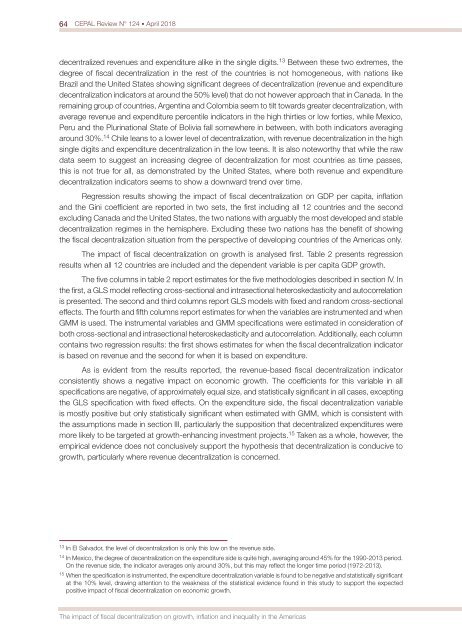CEPAL Review no. 124
April 2018
April 2018
You also want an ePaper? Increase the reach of your titles
YUMPU automatically turns print PDFs into web optimized ePapers that Google loves.
64 <strong>CEPAL</strong> <strong>Review</strong> N° <strong>124</strong> • April 2018<br />
decentralized revenues and expenditure alike in the single digits. 13 Between these two extremes, the<br />
degree of fiscal decentralization in the rest of the countries is <strong>no</strong>t homogeneous, with nations like<br />
Brazil and the United States showing significant degrees of decentralization (revenue and expenditure<br />
decentralization indicators at around the 50% level) that do <strong>no</strong>t however approach that in Canada. In the<br />
remaining group of countries, Argentina and Colombia seem to tilt towards greater decentralization, with<br />
average revenue and expenditure percentile indicators in the high thirties or low forties, while Mexico,<br />
Peru and the Plurinational State of Bolivia fall somewhere in between, with both indicators averaging<br />
around 30%. 14 Chile leans to a lower level of decentralization, with revenue decentralization in the high<br />
single digits and expenditure decentralization in the low teens. It is also <strong>no</strong>teworthy that while the raw<br />
data seem to suggest an increasing degree of decentralization for most countries as time passes,<br />
this is <strong>no</strong>t true for all, as demonstrated by the United States, where both revenue and expenditure<br />
decentralization indicators seems to show a downward trend over time.<br />
Regression results showing the impact of fiscal decentralization on GDP per capita, inflation<br />
and the Gini coefficient are reported in two sets, the first including all 12 countries and the second<br />
excluding Canada and the United States, the two nations with arguably the most developed and stable<br />
decentralization regimes in the hemisphere. Excluding these two nations has the benefit of showing<br />
the fiscal decentralization situation from the perspective of developing countries of the Americas only.<br />
The impact of fiscal decentralization on growth is analysed first. Table 2 presents regression<br />
results when all 12 countries are included and the dependent variable is per capita GDP growth.<br />
The five columns in table 2 report estimates for the five methodologies described in section IV. In<br />
the first, a GLS model reflecting cross-sectional and intrasectional heteroskedasticity and autocorrelation<br />
is presented. The second and third columns report GLS models with fixed and random cross-sectional<br />
effects. The fourth and fifth columns report estimates for when the variables are instrumented and when<br />
GMM is used. The instrumental variables and GMM specifications were estimated in consideration of<br />
both cross-sectional and intrasectional heteroskedasticity and autocorrelation. Additionally, each column<br />
contains two regression results: the first shows estimates for when the fiscal decentralization indicator<br />
is based on revenue and the second for when it is based on expenditure.<br />
As is evident from the results reported, the revenue-based fiscal decentralization indicator<br />
consistently shows a negative impact on eco<strong>no</strong>mic growth. The coefficients for this variable in all<br />
specifications are negative, of approximately equal size, and statistically significant in all cases, excepting<br />
the GLS specification with fixed effects. On the expenditure side, the fiscal decentralization variable<br />
is mostly positive but only statistically significant when estimated with GMM, which is consistent with<br />
the assumptions made in section III, particularly the supposition that decentralized expenditures were<br />
more likely to be targeted at growth-enhancing investment projects. 15 Taken as a whole, however, the<br />
empirical evidence does <strong>no</strong>t conclusively support the hypothesis that decentralization is conducive to<br />
growth, particularly where revenue decentralization is concerned.<br />
13<br />
In El Salvador, the level of decentralization is only this low on the revenue side.<br />
14<br />
In Mexico, the degree of decentralization on the expenditure side is quite high, averaging around 45% for the 1990-2013 period.<br />
On the revenue side, the indicator averages only around 30%, but this may reflect the longer time period (1972-2013).<br />
15<br />
When the specification is instrumented, the expenditure decentralization variable is found to be negative and statistically significant<br />
at the 10% level, drawing attention to the weakness of the statistical evidence found in this study to support the expected<br />
positive impact of fiscal decentralization on eco<strong>no</strong>mic growth.<br />
The impact of fiscal decentralization on growth, inflation and inequality in the Americas


















